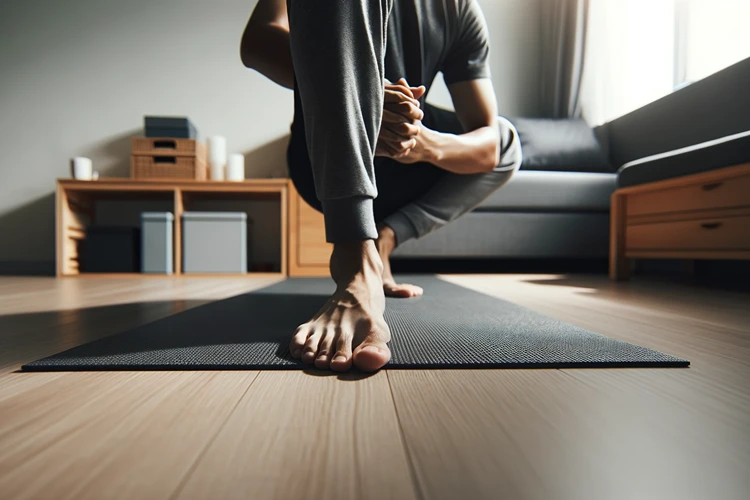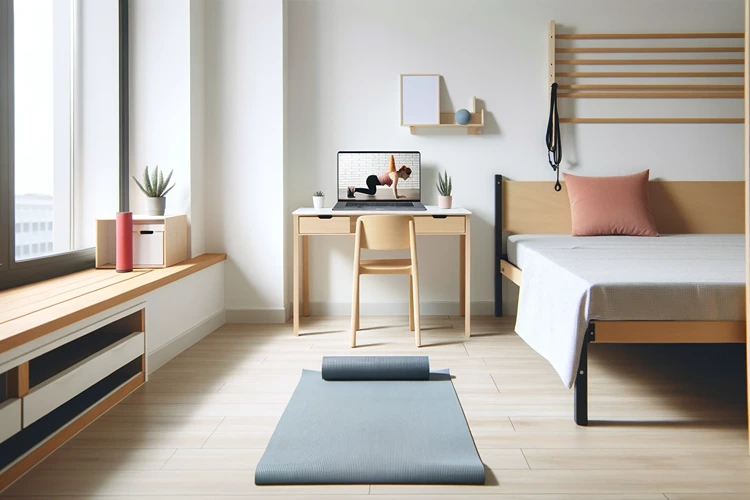Struggling to stay active in a cramped dorm room or a tiny apartment? You’re not alone. Many college students find it challenging to incorporate fitness into their busy schedules, especially when space is limited. But staying active is crucial, not just for your physical health but for your mental well-being too. This article will guide you through simple exercises tailored for small spaces, ensuring you can keep fit without needing a gym membership.
The Importance of Staying Active in College
Physical activity is a cornerstone of good health, reducing the risk of chronic diseases, improving mental health, and boosting academic performance. For college students, it’s a vital stress reliever and a way to maintain balance in a demanding academic environment.
Maximizing Small Spaces for Exercise
Even in the smallest of rooms, there are effective ways to exercise. The key is choosing activities that require minimal space and equipment.
Bodyweight Workouts
Bodyweight exercises are perfect for small spaces. They require no equipment and can be easily modified to increase or decrease difficulty. Here are a few to get you started:
- Push-ups: Strengthen your chest, shoulders, and triceps.
- Squats: Build your leg and glute muscles.
- Planks: Improve core strength and stability.
These exercises can be done in a sequence to create a full-body workout, taking up no more room than the size of a yoga mat.
Yoga and Stretching

Yoga is not only adaptable to small spaces but also excellent for reducing stress and improving flexibility. Focus on poses and stretches that can be done on a mat, utilizing vertical space rather than horizontal. Yoga apps and online tutorials can guide you through sequences that fit your space and skill level.
High-Intensity Interval Training (HIIT)
HIIT workouts are efficient and effective, making them ideal for busy students. These routines alternate between intense bursts of activity and fixed periods of less-intense activity or rest. A 20-minute HIIT session can be more beneficial than jogging for an hour, and it can easily be done in a tight space.
Helpful Hint:
Use a timer app on your phone to keep track of your HIIT intervals. Many free apps are designed specifically for this type of workout, helping you stay focused and on pace.
Nutrition and Hydration
Exercise is just one part of the wellness puzzle. Proper nutrition and staying hydrated are equally important, especially for active college students. Ensure you’re fueling your body with balanced meals and drinking plenty of water throughout the day to support your fitness goals.
Creating a Routine That Works for You
Finding time to exercise can be a challenge with a packed academic schedule. However, integrating short exercise sessions into your daily routine can make it more manageable. Aim for at least 30 minutes of moderate exercise most days of the week, breaking it down into shorter sessions if needed.
Overcoming Barriers to Exercise
Time constraints, lack of motivation, and limited space are common challenges college students face when trying to maintain an exercise routine. Here’s how you can address these barriers:
Finding Time for Fitness
With classes, assignments, and social commitments, finding time to exercise can seem daunting. However, integrating physical activity into your daily routine can be simpler than you think. Consider short, 10-minute workouts between study sessions, or use active breaks, like walking or stretching, to clear your mind and move your body.
Staying Motivated
Motivation can wane, especially when progress seems slow or life gets busy. Setting small, achievable goals can help maintain focus and motivation. Tracking your progress, whether through a journal or an app, can also provide a visual reminder of how far you’ve come. Remember, consistency is key to seeing results.
Utilizing Limited Space Creatively
Limited space doesn’t mean limited possibilities. Use furniture as workout equipment—for instance, chairs for tricep dips or beds for inclined push-ups. Also, consider activities that require minimal room but offer significant health benefits, such as jumping jacks, high knees, or even dancing.
Equipment-Free Exercises for Every College Student
No equipment? No problem. You can achieve a comprehensive workout using just your body weight. These exercises are perfect for small spaces and require no additional gear.
Core Strengtheners
Core exercises are crucial for overall stability and can be performed in a tight space. Planks, sit-ups, and leg raises are effective moves that target your entire core without moving from your spot.
Leg and Glute Workouts
For lower body strength, focus on squats, lunges, and glute bridges. These exercises engage major muscle groups in the legs and buttocks, building strength and endurance.
- Vary your squat stance to target different muscles.
- Add pulse movements at the bottom of lunges for an extra challenge.
Upper Body and Arms
Push-ups, tricep dips using a chair, and arm circles are great for targeting your upper body. For added intensity, experiment with push-up variations or increase the number of repetitions.
Remember, the key to a successful workout, especially in a small space, is adaptation. Listen to your body, adjust as necessary, and maintain consistency. With these strategies and exercises, you can enjoy a fulfilling workout routine that fits your lifestyle and space constraints.
Making Exercise a Social Activity
Exercising with friends or classmates can increase motivation and accountability. Organize small workout groups, virtual fitness challenges, or even outdoor activities that adhere to social distancing guidelines. Socializing through fitness can make exercising more enjoyable and less of a chore.
Listening to Your Body
While regular exercise is beneficial, it’s crucial to listen to your body and avoid overexertion. Rest days are important for muscle recovery and preventing injury. If you’re feeling particularly fatigued or sore, consider lighter activities such as walking or yoga.
Helpful Hint:
Stay hydrated and eat a balanced diet to support your exercise routine. Proper nutrition can significantly impact your energy levels and recovery times.
FAQs
Wrapping Up
Incorporating simple exercises into your daily routine as a college student, even in small spaces, is not only feasible but also essential for your physical and mental well-being. By creatively using your available space, setting realistic goals, and perhaps involving your peers, you can build a fitness routine that fits seamlessly into your college life, enhancing both your health and your academic performance.
Additional Resources
- Yoga Journal: Provides yoga poses, sequences, and tips suitable for all levels, including beginners and those limited by space.
- Darebee: A non-profit providing free access to fitness resources, including workouts, challenges, and fitness plans for people at all fitness levels.
